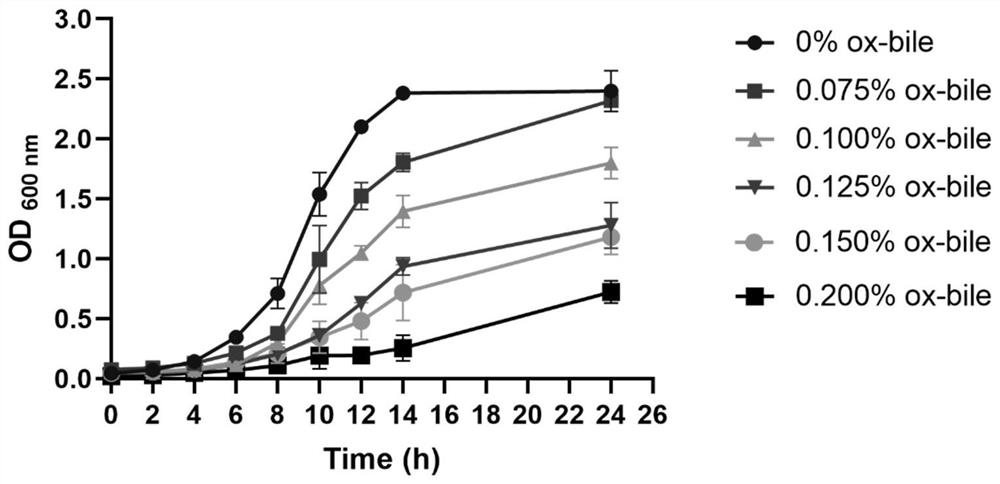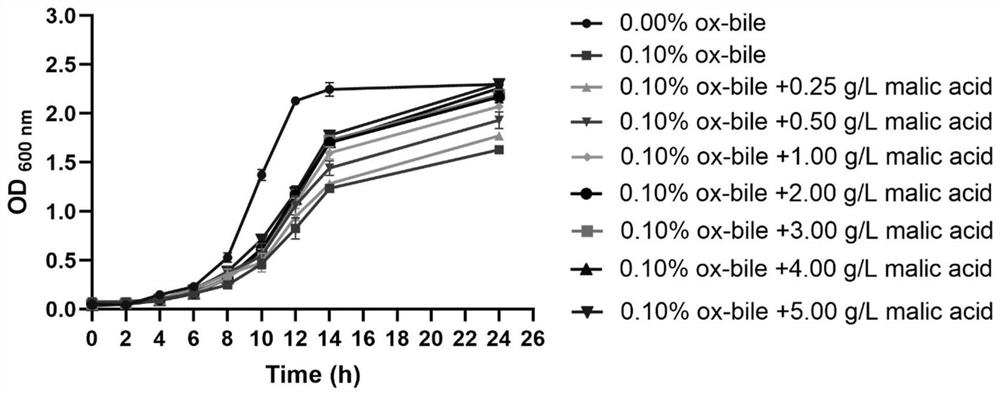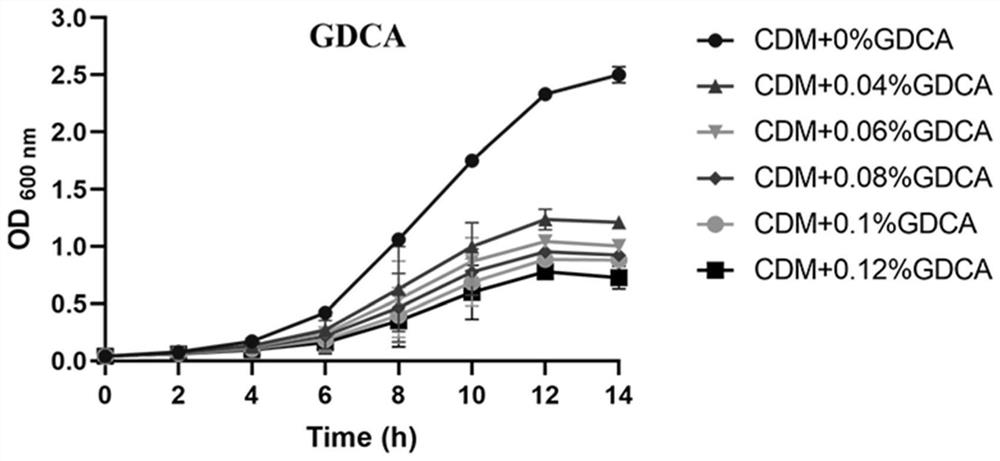Method for improving bile salt tolerance of lactobacillus and application thereof
A technology of Lactobacillus and Lactobacillus plantarum, applied in the field of food science, can solve the problems of changing cell surface hydrophobicity and potential, destroying bacterial permeability and fluidity, protein misfolding and denaturation, etc., achieving good application prospects and low cost Low, the effect of solving the negative impact
- Summary
- Abstract
- Description
- Claims
- Application Information
AI Technical Summary
Problems solved by technology
Method used
Image
Examples
example 1
[0036] Example 1: Different concentrations of L-malic acid improve the effect of Lactobacillus paracasei L9 on the resistance of mixed bile salts
[0037] The growth medium (CDM) used in this example includes: 200mL 100mM potassium phosphate buffer, 1g sodium acetate, 0.6g triammonium citrate, 0.5g ascorbic acid, 10g glucose, MgSO 4 0.5g, MnSO 4 0.25g, 10000×ZnSO 4 Add 100 μL of stock solution, 10 mL of 100×vitamin stock solution, 10 mL of 100× nucleic acid stock solution, 10 g of tryptone, 1 mL of Tween-80, 1 mL of glycerin, add 800 mL of distilled water, adjust the pH to 6.8, and make up to 1 L.
[0038] Lactobacillus paracasei L9 was inoculated in the CDM medium at 2%, and mixed bile salts were added at a concentration of 0%-0.2% (w / v, g / mL, the same below) to the medium, and stood at 37°C Incubate, measure OD every two hours 600The value of the growth curve was measured to compare the inhibitory effect of different concentrations of mixed bile salts on the growth of L...
example 2
[0040] Example 2: The impact of different concentrations of L-malic acid improving Lactobacillus paracasei L9 on the resistance of single bile salt glycine deoxycholate (GDCA)
[0041] The growth medium used in this example is the same as Example 1. Lactobacillus paracasei L9 was inoculated in CDM medium at 2%, and single bile salt GDCA bile salt was added to the medium at a concentration of 0%, 0.04%, 0.06%, 0.08%, 0.1% and 0.12%, at 37°C Static culture, measure OD every two hours 600nm value. The result is as image 3 As shown, the concentration of 0.08% GDCA was selected to evaluate the effect of different concentrations of L-malic acid on improving the resistance of L9 to single bile salt GDCA.
[0042] Then Lactobacillus paracasei L9 was inoculated at 2% in the CDM medium containing 0.08% GDCA while adding different concentrations of L-malic acid to adjust the pH to 6.8. It can be found from the measurement results of the growth curve, such as Figure 4 It is shown t...
example 3
[0043] Example 3: L-malic acid is to the assay result of improving the bile salt tolerance of various lactic acid bacteria
[0044] The CDM medium used in this example is the same as Example 1. Use CDM medium to continuously activate 11 different strains of Lactobacillus for 2-3 generations, and inoculate the activated strains with 2% inoculum to 0.2% mixed bile salts with L-malic acid content of 0g / L and 5g / L respectively In the CDM medium, adjust the pH to 6.8, culture statically at 37°C, and measure the OD for 14 hours 600nm The absorbance was compared with the absorbance grown in CDM without adding bile salts, and the ratio of absorbance between bile salts treated and untreated was used as an index to evaluate the salt tolerance of different lactobacilli.
[0045] Such as Figure 5 As shown, compared with adding 0.2% mixed bile salt group, adding L-malic acid to bile salt can significantly improve the bile salt tolerance of 11 strains of lactic acid bacteria, including L...
PUM
 Login to View More
Login to View More Abstract
Description
Claims
Application Information
 Login to View More
Login to View More - R&D
- Intellectual Property
- Life Sciences
- Materials
- Tech Scout
- Unparalleled Data Quality
- Higher Quality Content
- 60% Fewer Hallucinations
Browse by: Latest US Patents, China's latest patents, Technical Efficacy Thesaurus, Application Domain, Technology Topic, Popular Technical Reports.
© 2025 PatSnap. All rights reserved.Legal|Privacy policy|Modern Slavery Act Transparency Statement|Sitemap|About US| Contact US: help@patsnap.com



